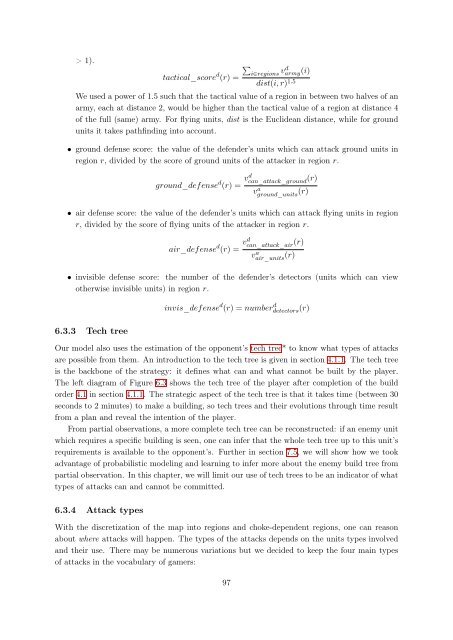Bayesian Programming and Learning for Multi-Player Video Games ...
Bayesian Programming and Learning for Multi-Player Video Games ...
Bayesian Programming and Learning for Multi-Player Video Games ...
Create successful ePaper yourself
Turn your PDF publications into a flip-book with our unique Google optimized e-Paper software.
1).<br />
tactical_score d (r) =<br />
�<br />
i∈regions vd army(i)<br />
dist(i, r) 1.5<br />
We used a power of 1.5 such that the tactical value of a region in between two halves of an<br />
army, each at distance 2, would be higher than the tactical value of a region at distance 4<br />
of the full (same) army. For flying units, dist is the Euclidean distance, while <strong>for</strong> ground<br />
units it takes pathfinding into account.<br />
• ground defense score: the value of the defender’s units which can attack ground units in<br />
region r, divided by the score of ground units of the attacker in region r.<br />
ground_defense d (r) = vd can_attack_ground (r)<br />
v a ground_units (r)<br />
• air defense score: the value of the defender’s units which can attack flying units in region<br />
r, divided by the score of flying units of the attacker in region r.<br />
air_defense d (r) = vd can_attack_air (r)<br />
v a air_units (r)<br />
• invisible defense score: the number of the defender’s detectors (units which can view<br />
otherwise invisible units) in region r.<br />
6.3.3 Tech tree<br />
invis_defense d (r) = number d detectors (r)<br />
Our model also uses the estimation of the opponent’s tech tree* to know what types of attacks<br />
are possible from them. An introduction to the tech tree is given in section 4.1.1. The tech tree<br />
is the backbone of the strategy: it defines what can <strong>and</strong> what cannot be built by the player.<br />
The left diagram of Figure 6.3 shows the tech tree of the player after completion of the build<br />
order 4.1 in section 4.1.1. The strategic aspect of the tech tree is that it takes time (between 30<br />
seconds to 2 minutes) to make a building, so tech trees <strong>and</strong> their evolutions through time result<br />
from a plan <strong>and</strong> reveal the intention of the player.<br />
From partial observations, a more complete tech tree can be reconstructed: if an enemy unit<br />
which requires a specific building is seen, one can infer that the whole tech tree up to this unit’s<br />
requirements is available to the opponent’s. Further in section 7.5, we will show how we took<br />
advantage of probabilistic modeling <strong>and</strong> learning to infer more about the enemy build tree from<br />
partial observation. In this chapter, we will limit our use of tech trees to be an indicator of what<br />
types of attacks can <strong>and</strong> cannot be committed.<br />
6.3.4 Attack types<br />
With the discretization of the map into regions <strong>and</strong> choke-dependent regions, one can reason<br />
about where attacks will happen. The types of the attacks depends on the units types involved<br />
<strong>and</strong> their use. There may be numerous variations but we decided to keep the four main types<br />
of attacks in the vocabulary of gamers:<br />
97


